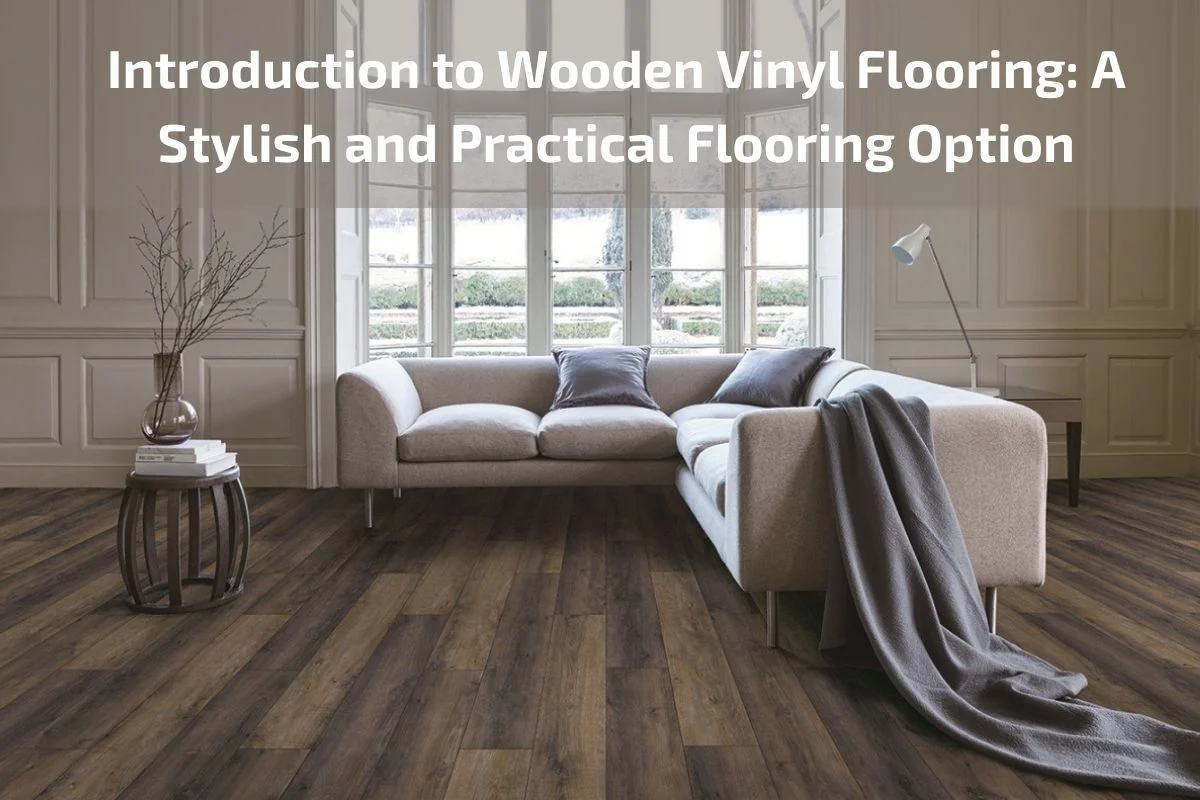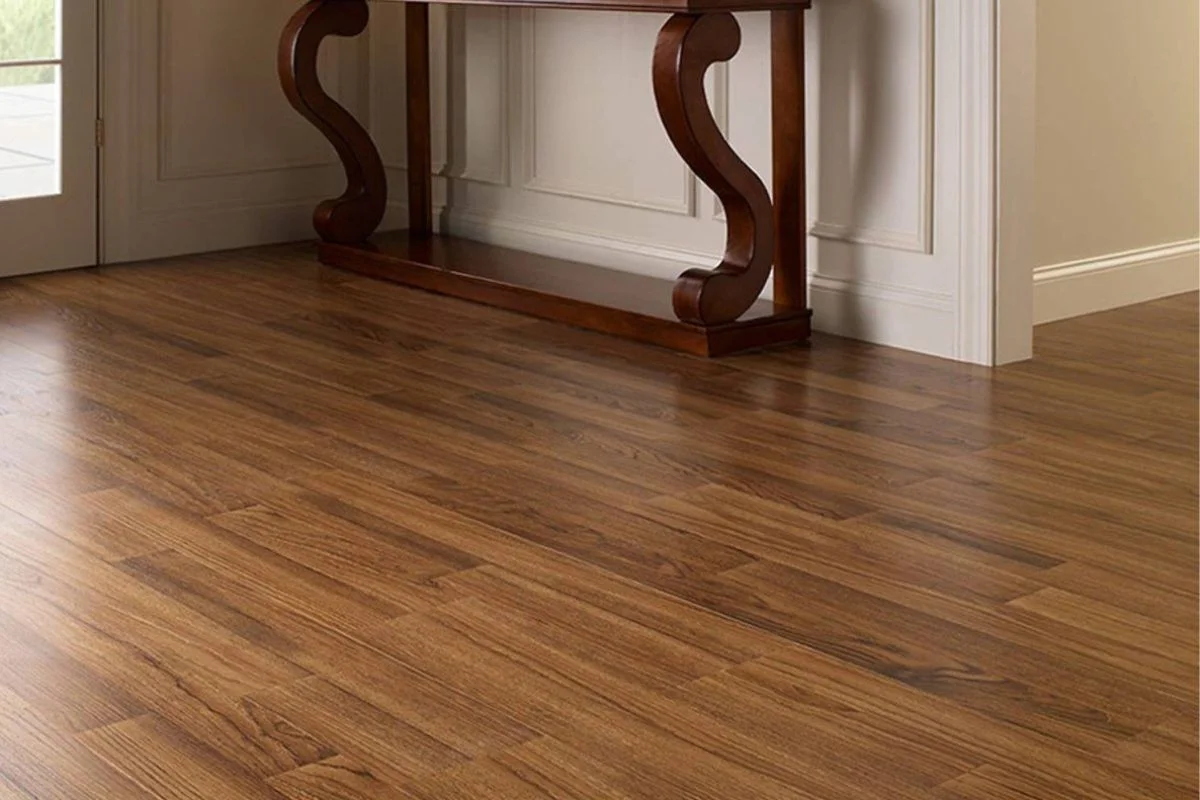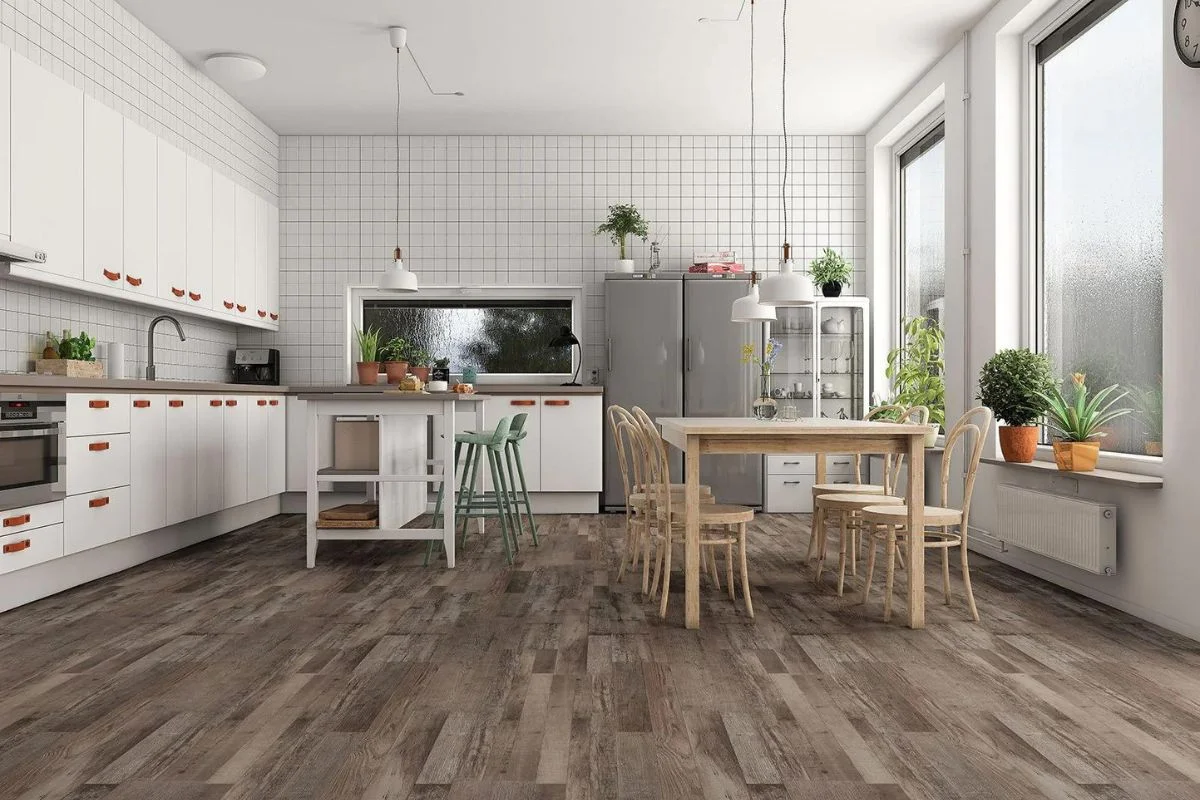
Introduction to Wooden Vinyl Flooring: A Stylish and Practical Flooring Option
Wooden vinyl flooring represents a remarkable innovation in the world of interior design, offering a perfect blend of style, durability, and practicality. As homeowners and designers seek flooring solutions that marry aesthetic appeal with functionality, wooden vinyl flooring emerges as a versatile option that meets diverse needs and preferences.
With its stunning resemblance to hardwood flooring, wooden vinyl flooring brings the timeless elegance of wood into modern spaces while offering numerous advantages over traditional materials. Whether you’re renovating a home, designing a commercial space, or simply looking to upgrade your flooring, wooden vinyl presents an enticing proposition.
Definition and Overview Wooden Vinyl Flooring
Wooden vinyl flooring, also known as luxury vinyl flooring (LVF), is a versatile and innovative flooring option that replicates the natural beauty of hardwood floors while offering enhanced durability and practicality. It is composed of multiple layers, including a sturdy core, a vinyl layer with a printed design that mimics wood grain patterns, and a protective wear layer on top.
This type of flooring combines the aesthetic appeal of wood with the resilience of vinyl, making it an attractive choice for residential and commercial spaces alike. Wooden vinyl flooring is available in a wide range of styles, colors, and finishes, allowing homeowners and designers to achieve the desired look and feel for their interiors.
The core layer of wooden vinyl flooring is typically made of PVC (polyvinyl chloride) or SPC (stone plastic composite) for added stability and water resistance. This makes it suitable for installation in areas prone to moisture, such as kitchens, bathrooms, and basements. Additionally, wooden vinyl flooring is often equipped with features like click-lock installation systems, making it easy to install and replace.
With advancements in printing and embossing technologies, modern wooden vinyl flooring closely resembles the texture and appearance of natural hardwood, providing a cost-effective alternative without compromising on style or quality. It offers superior resistance to scratches, stains, and fading, making it ideal for high-traffic areas in both residential and commercial settings.
Advantages and Disadvantages of Wooden Vinyl Flooring
Advantages:
- Durability and Longevity: Wooden vinyl flooring is highly durable and resistant to scratches, dents, and stains, making it suitable for high-traffic areas in homes and commercial spaces.
- Affordability: Compared to hardwood flooring, wooden vinyl flooring is more budget-friendly, offering a cost-effective alternative without compromising on aesthetics or quality.
- Wide Range of Styles and Designs: Wooden vinyl flooring comes in a variety of styles, colors, and finishes, allowing homeowners and designers to choose options that complement their interior decor and personal preferences.
- Easy Installation: Many wooden vinyl flooring options feature click-lock installation systems, making them easy to install without the need for professional assistance. This can save time and money during the installation process.
- Low Maintenance: Wooden vinyl flooring is easy to clean and maintain, requiring regular sweeping and occasional mopping to keep it looking like new. Unlike hardwood flooring, it does not require periodic refinishing or sealing.
- Water Resistance: With its water-resistant properties, wooden vinyl flooring is suitable for use in moisture-prone areas such as kitchens, bathrooms, and basements. It can withstand spills and humidity without warping or damage.
Disadvantages:
- Not as Environmentally Friendly: While some wooden vinyl flooring options are made with eco-friendly materials and manufacturing processes, others may contain PVC or other chemicals that can have environmental impacts.
- Susceptible to Damage from Sharp Objects: While wooden vinyl flooring is durable, it can still be damaged by sharp objects or heavy furniture if not properly protected. Care should be taken to use furniture pads and avoid dragging heavy items across the surface.
- Limited Repair Options: In the event of damage or wear, repairing wooden vinyl flooring can be more challenging compared to hardwood flooring. Scratches or dents may require replacement of individual planks rather than simple refinishing.
- Less Resale Value: While wooden vinyl flooring offers many benefits, it may not add as much resale value to a home as hardwood flooring. Some homebuyers prefer the authenticity and prestige of natural wood floors.
- Can Emit Volatile Organic Compounds (VOCs): Certain types of vinyl flooring may emit VOCs, especially when first installed. Homeowners with sensitivities or concerns about indoor air quality should choose low-VOC or eco-friendly options.
- Prone to Fading in Sunlight: Direct sunlight exposure over time may cause wooden vinyl flooring to fade or discolor. Using window treatments to filter UV rays can help mitigate this issue.
Types and Styles of Wooden Vinyl Flooring
Wooden vinyl flooring comes in a variety of types and styles, offering homeowners and designers numerous options to suit their aesthetic preferences and functional requirements. Here are some common types and styles of wooden vinyl flooring:
Plank Vinyl Flooring:
- Plank vinyl flooring resembles traditional hardwood flooring, with long and narrow planks that mimic the look of real wood.
- Plank vinyl flooring is available in various widths and lengths, allowing for customization and versatility in design.
Tile Vinyl Flooring:
- Tile vinyl flooring replicates the appearance of natural stone or ceramic tile, with square or rectangular tiles that feature realistic textures and grout lines.
- Tile vinyl flooring offers the beauty of tile without the drawbacks of grout maintenance and installation complexity.
Embossed Finish:
- Embossed vinyl flooring features textured surfaces that mimic the look and feel of natural wood grain, adding depth and dimension to the flooring.
- Embossed finishes create a realistic appearance and enhance the overall visual appeal of wooden vinyl flooring.
Smooth Finish:
- Smooth vinyl flooring has a sleek and uniform surface without texture or embossing, providing a clean and modern look.
- Smooth finishes are easy to clean and maintain, making them suitable for contemporary interiors.
Wood Grain Patterns and Textures:
- Wooden vinyl flooring offers a wide range of wood grain patterns and textures, including oak, maple, walnut, pine, and exotic hardwoods.
- Each wood grain pattern and texture contributes to the flooring’s overall aesthetic and can be selected to complement existing decor.
Color Variations and Shades:
- Wooden vinyl flooring is available in an array of colors and shades, ranging from light and natural tones to rich and dark hues.
- Color variations allow homeowners and designers to achieve specific design goals, whether creating a bright and airy space or a cozy and intimate atmosphere.
Specialty Designs:
- Some manufacturers offer specialty designs and styles of wooden vinyl flooring, such as distressed or reclaimed wood looks, rustic farmhouse styles, and contemporary minimalist designs.
- Specialty designs cater to diverse tastes and design preferences, allowing for creative expression and customization in interior spaces.
Choosing the Right Wooden Vinyl Flooring for Your Space
Selecting the right wooden vinyl flooring for your space involves careful consideration of various factors, including aesthetic preferences, functional requirements, and budget constraints. Here are key considerations to help you choose the perfect wooden vinyl flooring for your home or commercial environment:
Considerations for Residential vs. Commercial Spaces:
- Traffic Levels: Assess the level of foot traffic in the space where the flooring will be installed. High-traffic areas may require more durable and wear-resistant vinyl flooring options.
- Design Preferences: Consider the overall design style and aesthetic of the space. Choose wooden vinyl flooring that complements existing décor elements and enhances the overall ambiance.
Matching Flooring Styles with Interior Décor:
- Color Palette: Consider the color scheme of the room and select wooden vinyl flooring that coordinates harmoniously with existing furniture, wall colors, and décor accessories.
- Design Elements: Pay attention to design elements such as furniture, fixtures, and architectural features. Choose flooring styles and patterns that enhance these elements and create visual cohesion.
Budget Constraints and Material Quality:
- Establish a budget for your flooring project and explore wooden vinyl flooring options that align with your financial constraints.
- Balance cost considerations with material quality and durability. Invest in high-quality vinyl flooring that offers superior wear resistance and longevity, even if it comes at a slightly higher price point.
Understanding Wear Layers and Thickness:
- Evaluate the wear layer thickness of different wooden vinyl flooring options. A thicker wear layer provides enhanced protection against scratches, stains, and fading.
- Consider the overall thickness of the vinyl planks or tiles. Thicker flooring products offer greater stability and sound absorption, especially in areas with heavy foot traffic.
Comparing Wooden Vinyl Flooring with Other Flooring Materials
When considering flooring options for your space, it’s important to weigh the pros and cons of different materials to make an informed decision. Here’s a comparison of wooden vinyl flooring with other popular flooring materials:
Hardwood Flooring:
Advantages:
- Timeless beauty and natural warmth.
- Longevity with proper care and maintenance.
- Can be refinished to extend lifespan.
Disadvantages:
- Higher cost compared to vinyl flooring.
- Susceptible to scratches, dents, and water damage.
- Limited installation options in moisture-prone areas.
Laminate Flooring:
Advantages:
- Affordable alternative to hardwood flooring.
- Durable and scratch-resistant surface.
- Easy to install and maintain.
Disadvantages:
- Limited design options compared to vinyl flooring.
- Susceptible to moisture damage if not properly sealed.
- Cannot be refinished like hardwood flooring.
Tile and Stone Flooring:
Advantages:
- Wide range of colors, patterns, and textures.
- Extremely durable and resistant to moisture.
- Easy to clean and maintain.
Disadvantages:
- Hard and cold underfoot, requiring rugs or underfloor heating.
- Installation can be labor-intensive and costly.
- Susceptible to cracks and chips if not properly installed.
Carpet Flooring:
Advantages:
- Soft and comfortable underfoot, providing warmth and insulation.
- Wide variety of colors, textures, and styles available.
- Absorbs sound and reduces noise levels.
Disadvantages:
- Prone to staining and trapping allergens and dust.
- Requires regular vacuuming and professional cleaning.
- Less durable compared to vinyl and hardwood flooring options.
Resilient Flooring (Linoleum, Vinyl Sheet Flooring):
Advantages:
- Affordable and versatile flooring option.
- Resistant to scratches, stains, and water damage.
- Easy to install and maintain.
- Disadvantages:
- Limited design options compared to wooden vinyl flooring.
- Can be prone to fading and discoloration over time.
- May emit VOCs (volatile organic compounds) during installation.

Maintenance and Care for Wooden Vinyl Flooring
Proper maintenance and care are essential to preserve the beauty and longevity of wooden vinyl flooring. Follow these guidelines to keep your flooring looking its best:
Regular Cleaning:
- Sweep or vacuum your wooden vinyl flooring regularly to remove dust, dirt, and debris.
- Use a soft-bristle broom or a vacuum cleaner with a brush attachment to avoid scratching the surface.
- Wipe up spills and splashes immediately with a clean, damp cloth to prevent staining or water damage.
Mopping:
- Damp mop your wooden vinyl flooring periodically using a mild detergent or vinyl floor cleaner diluted in water.
- Avoid using abrasive cleaners, ammonia-based products, or excessive water, as these can damage the flooring.
- Rinse the floor thoroughly with clean water after mopping to remove any residue or cleaning solution.
Protection from Furniture:
- Place felt pads or furniture coasters under heavy furniture legs to prevent scratches and dents on the flooring.
- Lift furniture when moving it across the floor to avoid dragging and damaging the surface.
Use Entrance Mats:
- Place entrance mats or rugs at entryways and high-traffic areas to trap dirt, grit, and moisture before they can reach the flooring.
- Clean or shake out entrance mats regularly to prevent accumulated dirt from scratching or dulling the surface.
Avoid Sharp Objects:
- Avoid dragging sharp or heavy objects across the wooden vinyl flooring, as these can cause scratches or gouges.
- Use furniture pads or coasters under chair legs, table legs, and other furniture to protect the flooring from damage.
Sunlight Protection:
- Use window treatments such as blinds or curtains to protect your wooden vinyl flooring from direct sunlight exposure.
- Prolonged exposure to sunlight can cause fading or discoloration of the flooring over time.
Preventive Maintenance:
- Trim pets’ nails regularly to prevent scratches on the flooring.
- Use floor mats or rugs in front of kitchen sinks, stoves, and other areas prone to spills and splashes.
- Avoid wearing high heels or shoes with cleats on the wooden vinyl flooring to prevent indentations or damage.
Professional Maintenance:
- Consider hiring a professional flooring cleaner for deep cleaning and maintenance periodically.
- Professional cleaners have specialized equipment and products to remove stubborn stains and restore the shine of your wooden vinyl flooring.
Conclusion
In conclusion, wooden vinyl flooring stands as a versatile and practical choice for homeowners and designers seeking the timeless beauty of hardwood with the added benefits of vinyl. With its durability, affordability, and wide range of styles and designs, wooden vinyl flooring offers an attractive solution for modern interiors.



0 comments